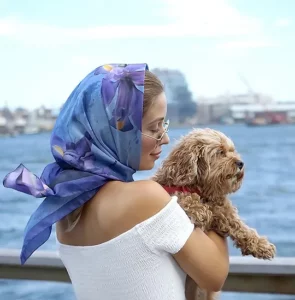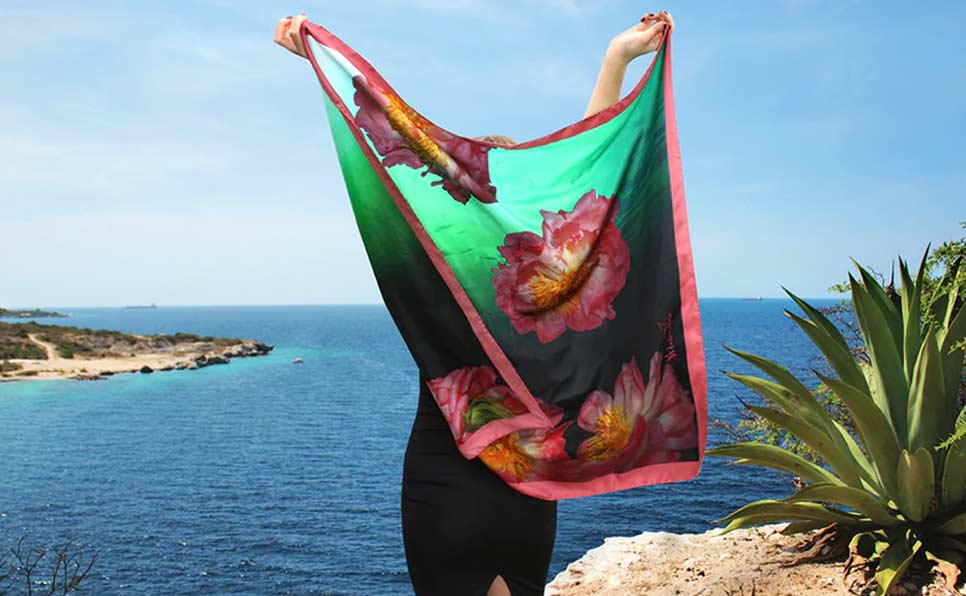
Career paths come in all shapes and sizes of which most are not linear. There are often twists and turns to get to where you want to be, but regardless of how treacherous the terrain, the key is always to wear good shoes and keep your feet firmly on the ground.
Like many successful businesswomen, artist Andrea DiFiore found her way to her current profession, as a creator of wearable art, in a somewhat roundabout fashion, having started her career years before as a high-end photo retoucher. Her story serves as inspiration to women trying to figure out their next chapter. Womensbiz Founder and Editor-in-Chief, Elaine Taylor-Gordon, recently sat down with DiFiore over Zoom to explore how she got to where she is today.
The Early Years
Born and raised in Queens, NY, to Italian-American parents, DiFiore attended neighborhood public schools. As a child, learning disabilities and social difficulties made school a challenge, but she always excelled in science and art. As the youngest of three siblings and the only girl in the family, she often found herself home alone but her paint-by-numbers and Play-Doh sets kept her busy for hours. Art became a welcome escape from the rigors of school and social issues which were compounded by being alone so often. She eventually discovered that art was something in which she was particularly good–as she was frequently solicited to create program covers for school performances—thus, becoming an artist, quickly became her career goal.
After high school, DiFiore attended the prestigious School of Visual Arts (SVA) in New York City where she became a studio assistant for American artist and filmmaker Larry Rivers. “There were just five of us and we were like a family, dysfunctional as can be. He was our patriarch. I met great people – Betty Friedan, Allen Ginsberg, and Abbie Hoffman, so that was kind of cool,” she says. She also became an academic advisor at SVA and taught herself retouching, which led to freelance jobs at Christian Dior and DC Comics until they eventually decided to bring retouching in-house to save money. But that was an opportunity for Andrea: Her high-end retouching work on Rolling Stone magazine’s monthly covers, eventually led her to Direct TV where she spent 10 years retouching posters for original content, films and TV, as well as corporate headshots for their company executives.
DiFiore was a single mother at the time, raising her daughter alone while working all day at Direct TV and writing a children’s book at night. When rumors percolated that AT&T was going to buy Direct TV, she said “‘OK, here’s my break.’ I had been there 10 years. I was making good money. I was writing my children’s book and I was illustrating in the evening while I was raising my daughter by myself.” I would get a payout. Life was looking good!

“My pot of gold was also my freedom. I knew they’d get rid of me first because I was there the longest and they paid me the most. So I had to wait for my severance pay and contracted bonus. With her “glass-half-full” mentality, she viewed this new development as a special opportunity. She had already started experimenting with flower prints. “I waited two more years for my due, while simultaneously working on my designs and trying to get my business going, but I tell you, I was working 10 hours a day. I’d come home and then cared for my daughter. I was exhausted,” she says.
A New Career Blooms
Being able to pivot and embrace change in this way is inspiring and something that many women strive to be able to do; so it’s logical that businesswomen have become masters at navigating change, comfortable with it or not. Some may pursue a career without any breaks, while others leave their jobs to have children and eventually try to get back into the workforce years later. Or perhaps they worked in one industry before the pandemic and now want to try something else, but don’t know how to transition. Regardless of the situation, we could all learn a great deal from DiFiore on how to change careers after starting out in a completely different place.

As she explains, “first I was creating retouching, then prints and then the scarves came later. I am a tactile person and started thinking how could a woman take this print with her? The scarf just sort of folds up into nothing, you can put it in your purse, and there’s my artwork, traveling with someone. I used to take scarves with me when traveling, so when I was on a Vespa, for example, I could take my scarf out and put it around my head so my hair wasn’t blowing in my face.”
Initially, her prints served as a statement about the environment. “The flowers were drowning in water. Initially they were called ‘Drowned Flowers.’ And then I reformatted those prints because I felt they lent themselves to textiles.” She adjusted her prints and decided to test them out on small scarves. “I wanted to take the art off the wall and put it around our bodies.” Suddenly, a brand-new business was born. As she describes, “I was always working in a dark room (doing retouching) and finally said ‘I’m tired of working in the dark. I’m coming out into the light. I’m going to create my own business.’”
Self-doubt was one of DiFiore’s greatest problems, especially her fear that she was too old to start a business in her 50s. One day, she voiced this concern to her professional coach, who pointed out that Colonel Sanders was 40 when he started Kentucky Fried Chicken. And didn’t perfect the recipe until he was almost fifty…and sold it at 73 for $2million. “ I said ok, but it’s still difficult not having any business experience, not having any marketing experience. I learned everything on my own. I learned how to be a copywriter, a photographer, and I did it myself. I built my own website. I had no help. It was just me and it took a long time’ I made my first sale because some women thought my scarves were really beautiful. Italy Magazine kept me afloat. Flower magazine helps me at holiday time. And then throughout the year I’ll get sales. I just got an order yesterday for one of the dog motif scarves. I’m not swimming in money, but I support myself. I still do retouching to help make ends meet.”
A Successful Second Act
Those nagging self-doubts frequently obscure our success as we struggle to define it. Nevertheless, Andrea DiFiore’s fortitude and commitment to embracing change and creating her second act later in life has been the key to her success and longevity. Lucky for her customers as well as for her own self-worth, she shows no signs of slowing down.
DiFiore’s gorgeous flower print and dog motif scarves are eco-friendly and can be purchased on her website at www.difiorenewyork.com. Proceeds from sales go to the non-profit Preserving Ocean Life.
Jennifer is a seasoned marketing and advertising professional who currently works as a senior marketing consultant and freelance writer/blogger for clients in the beauty, fashion, food & beverage, healthcare and financial industries. Her career highlights include her role as Marketing Director at Revlon where she spent 10 years managing and leading some of the most successful cosmetics and fragrance brands in the world. She also led the marketing at MD SolarSciences and worked at top advertising agencies DDB Needham and Publicis. Jennifer loves helping entrepreneurs create comprehensive marketing and content strategies and donates her time to The Acceleration Project, a company that provides professional guidance to underserved small businesses.

